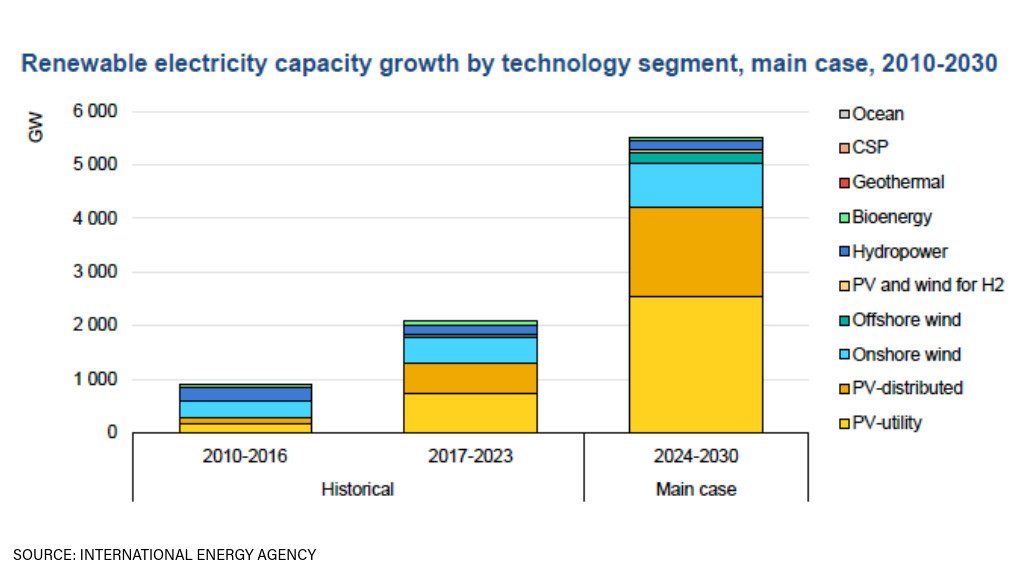Cost-competitiveness to underpin surge in global renewables roll-out to 2030 - IEA
Led by solar PV, renewables are poised to transform electricity systems across the globe this decade, with the world on course to add more than 5 500 GW by 2030, the International Energy Agency’s (IEA’s) ‘Renewables 2024’ report states.
Such additions would increase global renewable electricity generation to over 17 000 TWh, which is roughly equal to the current combined electricity demand of China, the EU, India and the US.
It will also involve a deployment pace that will be almost three times that witnessed between 2017 and 2023, when some 2 000 GW of capacity was added.
The report forecasts that renewables will be meeting nearly half of global electricity demand by 2030, up from 30% in 2023. In addition, the role of renewables in overall energy consumption, including heating and transportation, is forecast to rise from 13% in 2023 to nearly 20%.
“Renewables are moving faster than national governments can set targets for,” IEA executive director Fatih Birol says, noting that nearly 70 countries that collectively account for 80% of global renewable power capacity are poised to reach or surpass their current renewable ambitions for 2030.
“This is mainly driven not just by efforts to lower emissions or boost energy security – it’s increasingly because renewables today offer the cheapest option to add new power plants in almost all countries around the world,” Birol adds.
In 2023, global renewable capacity additions increased by more than 60% to almost 565 GW and 2024 is expected to be another record year, albeit at a more modest 20% growth rate. Yearly renewable capacity additions are expected to rise from 666 GW in 2024 to almost 935 GW in 2030.
Over the period to 2030, China is set to account for almost 60%, or more than 3 200 GW, of all renewable capacity installed worldwide, making the country home to almost half of the world’s total renewable power capacity.
However, India is expected to grow at the fastest rate among major economies.
AFRICA TO ADD 90 GW BY 2030
Although the outlook for sub-Saharan Africa is more subdued, owing to funding and policy uncertainty, the IEA is forecasting that almost 90 GW of new renewable capacity will be added in the region between 2024 to 2030, increasing the region’s current installed capacity by over 2.5 times.
“Expansion happens mainly in South Africa, which is responsible for installing nearly 40% of the region’s new capacity,” the report states.
Solar PV and wind additions make up nearly 80% of new capacity in the region, but outside of South Africa, hydropower makes up the majority of total additions.
Globally, solar PV is forecast to account for a massive 80% of the growth over the period, with the construction of new large solar power plants increasing alongside rooftop solar installations by companies and households.
Global solar manufacturing capacity, which is mostly located in China, is expected to surpass 1 100 GW by the end of 2024, more than double projected demand.
“Given the growing international focus on industrial competitiveness, solar PV manufacturing capacity is forecast to triple in both India and the US by 2030, helping global diversification.
“However, producing solar panels in the US costs three times as much as in China, and in India, it is twice as expensive.”
By the end of this decade, the IEA forecasts that the share of wind and solar PV alone in global electricity generation is set to double to 30%, which will require governments to ramp up their efforts to securely integrate these variable renewable sources into power systems.
“Recently, rates of curtailment – where renewable electricity generation isn’t put to use – have been increasing substantially, already reaching around 10% in several countries today.
“To address this, countries should focus on measures such as increasing power system flexibility,” the IEA states, highlighting the need to scale-up storage to 1 500 GW by 2030, as well as to implement demand-response measures at a larger scale.
The report also warns that grid investment is lagging the needs of the sector and states that 25-million kilometres of electricity grids will need to be built or modernised over the period.
Article Enquiry
Email Article
Save Article
Feedback
To advertise email advertising@creamermedia.co.za or click here
Comments
Press Office
Announcements
What's On
Subscribe to improve your user experience...
Option 1 (equivalent of R125 a month):
Receive a weekly copy of Creamer Media's Engineering News & Mining Weekly magazine
(print copy for those in South Africa and e-magazine for those outside of South Africa)
Receive daily email newsletters
Access to full search results
Access archive of magazine back copies
Access to Projects in Progress
Access to ONE Research Report of your choice in PDF format
Option 2 (equivalent of R375 a month):
All benefits from Option 1
PLUS
Access to Creamer Media's Research Channel Africa for ALL Research Reports, in PDF format, on various industrial and mining sectors
including Electricity; Water; Energy Transition; Hydrogen; Roads, Rail and Ports; Coal; Gold; Platinum; Battery Metals; etc.
Already a subscriber?
Forgotten your password?
Receive weekly copy of Creamer Media's Engineering News & Mining Weekly magazine (print copy for those in South Africa and e-magazine for those outside of South Africa)
➕
Recieve daily email newsletters
➕
Access to full search results
➕
Access archive of magazine back copies
➕
Access to Projects in Progress
➕
Access to ONE Research Report of your choice in PDF format
RESEARCH CHANNEL AFRICA
R4500 (equivalent of R375 a month)
SUBSCRIBEAll benefits from Option 1
➕
Access to Creamer Media's Research Channel Africa for ALL Research Reports on various industrial and mining sectors, in PDF format, including on:
Electricity
➕
Water
➕
Energy Transition
➕
Hydrogen
➕
Roads, Rail and Ports
➕
Coal
➕
Gold
➕
Platinum
➕
Battery Metals
➕
etc.
Receive all benefits from Option 1 or Option 2 delivered to numerous people at your company
➕
Multiple User names and Passwords for simultaneous log-ins
➕
Intranet integration access to all in your organisation

















